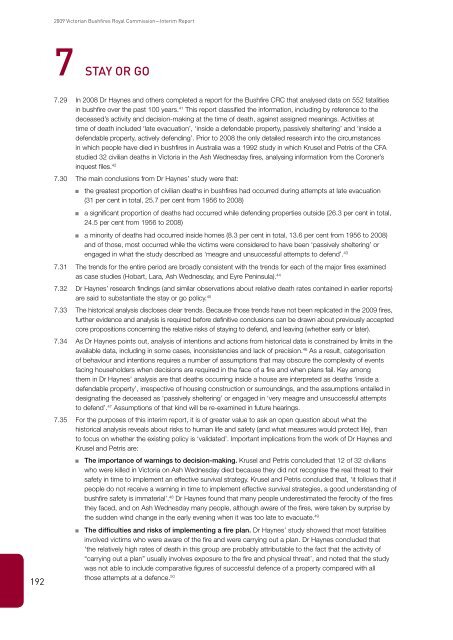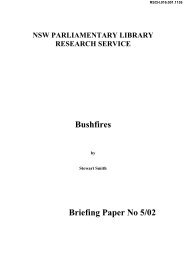Chapter 7 - Stay or go - 2009 Victorian Bushfires Royal Commission
Chapter 7 - Stay or go - 2009 Victorian Bushfires Royal Commission
Chapter 7 - Stay or go - 2009 Victorian Bushfires Royal Commission
Create successful ePaper yourself
Turn your PDF publications into a flip-book with our unique Google optimized e-Paper software.
<strong>2009</strong> Vict<strong>or</strong>ian <strong>Bushfires</strong> <strong>Royal</strong> <strong>Commission</strong>—Interim Rep<strong>or</strong>t<br />
7 <strong>Stay</strong> <strong>or</strong> Go<br />
192<br />
7.29<br />
7.30<br />
7.31<br />
7.32<br />
7.33<br />
7.34<br />
7.35<br />
In 2008 Dr Haynes and others completed a rep<strong>or</strong>t f<strong>or</strong> the Bushfire CRC that analysed data on 552 fatalities<br />
in bushfire over the past 100 years. 41 This rep<strong>or</strong>t classified the inf<strong>or</strong>mation, including by reference to the<br />
deceased’s activity and decision-making at the time of death, against assigned meanings. Activities at<br />
time of death included ‘late evacuation’, ‘inside a defendable property, passively sheltering’ and ‘inside a<br />
defendable property, actively defending’. Pri<strong>or</strong> to 2008 the only detailed research into the circumstances<br />
in which people have died in bushfires in Australia was a 1992 study in which Krusel and Petris of the CFA<br />
studied 32 civilian deaths in Vict<strong>or</strong>ia in the Ash Wednesday fires, analysing inf<strong>or</strong>mation from the C<strong>or</strong>oner’s<br />
inquest files. 42<br />
The main conclusions from Dr Haynes’ study were that:<br />
■■<br />
■■<br />
■■<br />
the greatest prop<strong>or</strong>tion of civilian deaths in bushfires had occurred during attempts at late evacuation<br />
(31 per cent in total, 25.7 per cent from 1956 to 2008)<br />
a significant prop<strong>or</strong>tion of deaths had occurred while defending properties outside (26.3 per cent in total,<br />
24.5 per cent from 1956 to 2008)<br />
a min<strong>or</strong>ity of deaths had occurred inside homes (8.3 per cent in total, 13.6 per cent from 1956 to 2008)<br />
and of those, most occurred while the victims were considered to have been ‘passively sheltering’ <strong>or</strong><br />
engaged in what the study described as ‘meagre and unsuccessful attempts to defend’. 43<br />
The trends f<strong>or</strong> the entire period are broadly consistent with the trends f<strong>or</strong> each of the maj<strong>or</strong> fires examined<br />
as case studies (Hobart, Lara, Ash Wednesday, and Eyre Peninsula). 44<br />
Dr Haynes’ research findings (and similar observations about relative death rates contained in earlier rep<strong>or</strong>ts)<br />
are said to substantiate the stay <strong>or</strong> <strong>go</strong> policy. 45<br />
The hist<strong>or</strong>ical analysis discloses clear trends. Because those trends have not been replicated in the <strong>2009</strong> fires,<br />
further evidence and analysis is required bef<strong>or</strong>e definitive conclusions can be drawn about previously accepted<br />
c<strong>or</strong>e propositions concerning the relative risks of staying to defend, and leaving (whether early <strong>or</strong> later).<br />
As Dr Haynes points out, analysis of intentions and actions from hist<strong>or</strong>ical data is constrained by limits in the<br />
available data, including in some cases, inconsistencies and lack of precision. 46 As a result, categ<strong>or</strong>isation<br />
of behaviour and intentions requires a number of assumptions that may obscure the complexity of events<br />
facing householders when decisions are required in the face of a fire and when plans fail. Key among<br />
them in Dr Haynes’ analysis are that deaths occurring inside a house are interpreted as deaths ‘inside a<br />
defendable property’, irrespective of housing construction <strong>or</strong> surroundings, and the assumptions entailed in<br />
designating the deceased as ‘passively sheltering’ <strong>or</strong> engaged in ‘very meagre and unsuccessful attempts<br />
to defend’. 47 Assumptions of that kind will be re-examined in future hearings.<br />
F<strong>or</strong> the purposes of this interim rep<strong>or</strong>t, it is of greater value to ask an open question about what the<br />
hist<strong>or</strong>ical analysis reveals about risks to human life and safety (and what measures would protect life), than<br />
to focus on whether the existing policy is ‘validated’. Imp<strong>or</strong>tant implications from the w<strong>or</strong>k of Dr Haynes and<br />
Krusel and Petris are:<br />
■ ■ The imp<strong>or</strong>tance of warnings to decision-making. Krusel and Petris concluded that 12 of 32 civilians<br />
who were killed in Vict<strong>or</strong>ia on Ash Wednesday died because they did not recognise the real threat to their<br />
safety in time to implement an effective survival strategy. Krusel and Petris concluded that, ‘it follows that if<br />
people do not receive a warning in time to implement effective survival strategies, a <strong>go</strong>od understanding of<br />
bushfire safety is immaterial’. 48 Dr Haynes found that many people underestimated the ferocity of the fires<br />
they faced, and on Ash Wednesday many people, although aware of the fires, were taken by surprise by<br />
the sudden wind change in the early evening when it was too late to evacuate. 49<br />
■ ■ The difficulties and risks of implementing a fire plan. Dr Haynes’ study showed that most fatalities<br />
involved victims who were aware of the fire and were carrying out a plan. Dr Haynes concluded that<br />
‘the relatively high rates of death in this group are probably attributable to the fact that the activity of<br />
“carrying out a plan” usually involves exposure to the fire and physical threat’, and noted that the study<br />
was not able to include comparative figures of successful defence of a property compared with all<br />
those attempts at a defence. 50
















